The Microsoft Surface Book 3 (15-Inch) Review: A Refreshing Dip Into Ice Lake
by Brett Howse on June 3, 2020 9:00 AM ESTBattery Life
One of the advantages of the Surface Book design is that it offers up a significant amount of space for battery cells, with around 22 Wh in the tablet, and another 63 Wh in the base, adding up to 85 Wh total capacity. But battery capacity is only part of the equation, with platform efficiency also being as important.
To test the battery life of the Surface Book 3, the display was set to 200 nits, and the total time was measured to discharge a 100% charged device in a couple of scenarios. We’ve dropped our old light test, since the workload was almost an idle time for modern devices, and will now be testing our heavy web workload, movie playback, and new to this review, the PCMark 10 Modern Office Battery life test.
Web Battery
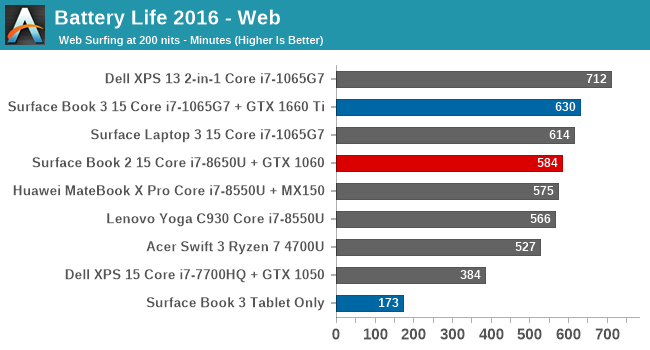
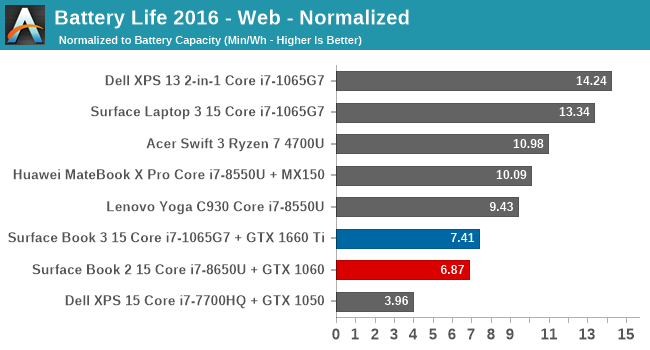
The extra battery capacity certainly helps the Surface Book 3 maintain all-day battery life. Despite the large, high-resolution display, the Surface Book 3 offers particularly good battery life at 10.5 hours on this test. It achieved 46 minutes more runtime than the Surface Book 2, and since they both share the same display, likely points to the efficiency gains of the new Ice Lake processor under load. There are devices that can achieve longer battery life, but since so much of the power draw is the display, they tend to have much lower power 1920x1080 offerings.
Movie Playback
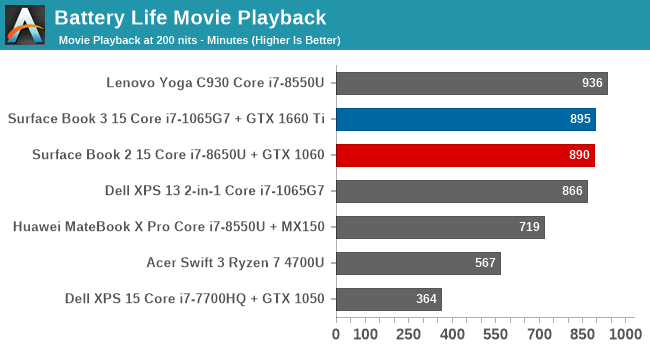
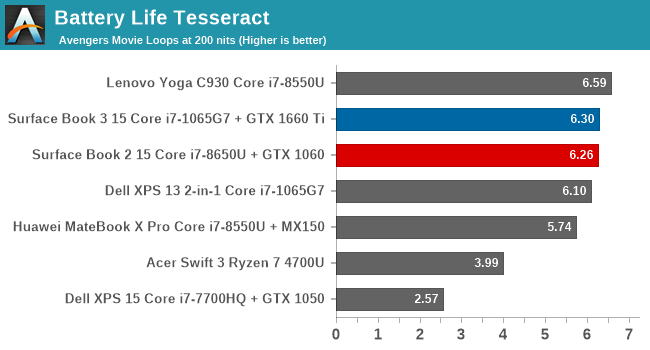
Movie playback tends to be one of the best ways to achieve battery life, since the video decode is offloaded to fixed-function hardware in the media block which can be very efficient. The Surface Book 3 achieves almost 15 hours of battery life in this test, outperforming the previous model by five minutes. Very impressive.
PCMark 10 Modern Office
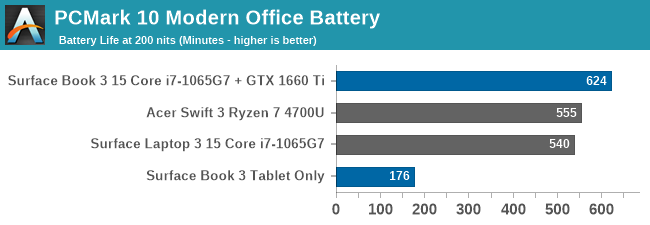
Adding in a new test means we unfortunately don’t have the backlog of data from previous devices, so for now please accept this smaller comparison. The large battery once again does what it intended, offering almost 10.5 hours here as well. The Modern Office battery test runs three scenarios, each at ten minutes in length. If a device finishes the test sooner, it will idle until the ten minutes is up, so faster devices will be able to get into the “hurry up and wait” stage which should be a benefit in this test.
Platform Power
The big 15-inch high-resolution display accounts for a big chunk of the Surface Book 3's power draw. With the display at the same 200 nits brightness we test at, measured power draw of the system was around 6.5 Watts, but with the display off, idle power draw dropped to as low as 650 mW, which is very impressive. Microsoft has certainly done their homework. That means the display accounts for almost six watts of draw at 200 nits. High DPI has its price, and that is battery life.
Also of note, the Surface Book 3 will disable the discrete GPU if the battery falls below a certain percentage, which seems to be around 8-10% charge. This was confirmed as by-design, and the NVIDIA GPU will no longer show up in device manager until the device is charged and rebootted.
Charge Time
Microsoft includes a 127-Watt AC adapter with the new Surface Book 3, which will prevent it from discharging under load like the previous model could, but as with most devices, the amount of power you put into the battery is never that high. If you need to charge the laptop on the go, it can also be charged over the USB-C connector, although you won’t achieve the power provided by the included adapter.

Interestingly, with the batteries split into two sections, you would think Microsoft would be able to charge the Surface Book quicker than most other devices, but they are pretty conservative with the power going back into the battery, likely to increase battery longevity. As such, charging from empty still takes over 2.5 hours.










125 Comments
View All Comments
Aisalem - Wednesday, June 3, 2020 - link
Did you ever try to use Surface Book outdoors?I can only say that as soon as the temp is over 90F (around 30C) my Book 2 will overheat and lock CPU at 800MHz, it's simply piece of junk at that time.
As much as I like it when used in cold office I will never buy another MS product due to that and also luck of proper servicing.
damianrobertjones - Wednesday, June 3, 2020 - link
Good luck with any oem as they've ALL had issues at one point in time.kenjiwing - Wednesday, June 3, 2020 - link
Does anyone know if the surface book 3 can drive two 4k displays at 60hz? The 2 could not because it used the internal intel chip instead of the nvidia one for external displays.timecop1818 - Wednesday, June 3, 2020 - link
i7-1065G7 supports DisplayPort 1.4, so theoretically with a type-c to dual displayport converter/MST hub you should be able to do 2x 4K@60. See https://dancharblog.wordpress.com/2019/10/10/dual-... for required bits.kenjiwing - Wednesday, June 3, 2020 - link
Thank you!FXi - Wednesday, June 3, 2020 - link
Just be wary because the SB2 cannot drive any external display using the 1060 GPU. Since that was not listed as an improvement of the SB3 you'll want to check carefully. You may be fine using the integrated Intel GPU to drive 2 4K displays or you may not. But no one reviewing has yet checked to see if the 1660 can drive any external connector (USB C or via the dock).kenjiwing - Thursday, June 4, 2020 - link
Well shitdamianrobertjones - Wednesday, June 3, 2020 - link
A full SD card slot would have been AMAZING! (Well... better, at least).amb9800 - Wednesday, June 3, 2020 - link
It has a full-sized SD card slot...ikjadoon - Wednesday, June 3, 2020 - link
Surface Book 3 (Anandtech, 2020):"Although the Surface Book 3 can ship with the fastest SSD Microsoft has ever put in a notebook, that was not the case for the review unit, which was actually slower than the 256 GB SSD in the Surface Laptop 3."
Surface Book (Anandtech, 2015):
"On a premium device like the Surface Book, I would expect only the best, and while the drive may meet their internal performance levels, a cacheless TLC based SSD in a premium device is not necessary."
Storage really cannot be that complex a decision. There are, at most, 5-6 OEM SSDs used on high-end premium notebooks.
Glad to see platform & internal improvements and a big thank you to Microsoft for outfitting these with at least decent webcams. For the price, though:
-- no TB3 is a sore spot (Microsoft Docks are obscenely priced and come with no smaller options...not to mention how buggy they have been)
-- a *single* USB type-C port is egregious in a premium 2020 15" notebook
-- that slow charging is painful for this "executives on the move" niche market (0-80% in an hour: curious they give the one-hour charging speed instead of 30 minutes...)
Are these nitpicks? Sure. But for a device that claims to "serve the high-end market", Microsoft continuously fails to read the room in a few crucial ways.
What else can do you, besides pity Panos Panay's Steve Jobs routine?